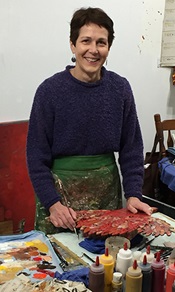Lynn O’Brien (b.1960)
Pictured, from left (all 2019):
- King of the Woods (Pileated Woodpecker)
- Neighborhood Gossip (Blue Jay)
- Little Dynamo (Wren)
Materials: Collage with wood, acrylic paint on paper, found objects
Dimensions: 23 x 15 ½”, 24 ½ x 23”, and 20 x 21 ½”
Location at Summa Health: Dr. Gary B. and Pamela S. Williams Tower on the Akron Campus (141 N. Forge St.), Blue Neighborhood, Second Floor Hallway, Outside Patient Rooms H2-310 and H2-311
About the Art

Cleveland artist Lynn O’Brien’s vibrant, low-relief mixed-media sculptures of birds bring an element of nature to the walls of Summa Health’s new patient tower. King of the Woods (Pileated Woodpecker), Neighborhood Gossip (Blue Jay), and Little Dynamo (Wren) are striking examples of O’Brien’s unique technique, which combines collage, painting, and sculpture.
A longtime admirer of birds as artistic subjects, O’Brien began experimenting with three-dimensional works several years ago. Her birds are constructed from painted and collaged paper, cut and shaped into layered forms, often incorporating found objects. Each piece is meticulously crafted, with the birds’ distinctive features, colors, and behaviors thoughtfully reflected in the layers of materials she uses.
The collage process involves creating intricate designs using painted paper, stamps, and even transparent materials, such as pages from Japanese books. O’Brien also writes over some of these materials, infusing them with personal thoughts that add depth to the work. The resulting birds, such as the animated pose of the blue jay or the whimsical pileated woodpecker, are both visually and symbolically rich. O’Brien’s decision to omit feet in some works invites the viewer to imagine the birds perched in space, while others, like the woodpecker, incorporate found objects that enhance the sense of movement and personality.
Each sculpture is mounted slightly off the wall, allowing it to "fly" in real space, with textured back frames painted in the same dense layers of color as the front. This added detail invites close inspection and reveals the complexity and depth of O’Brien's artistic process.
O’Brien’s Aviary series aims to expand on these bird-themed works, with plans for future pieces featuring local species such as juncos, house finches, and even larger flying flocks. These playful and inventive creations were chosen for the Summa Health Collection because of their unique approach to a beloved subject and their ability to engage and delight viewers.
About the Artist

O’Brien’s artistic journey is as multifaceted as her work. After earning a bachelor’s degree in business administration from the University of Massachusetts, she found herself yearning for creative expression. She returned to school, completing a bachelor’s degree in nursing, and has since worked as an operating room nurse. This professional background complements her artistic process, providing her with the discipline and focus required for both her medical and artistic careers.
O’Brien’s work offers a unique perspective, with her time-intensive research and experimentation in the studio providing a satisfying counterpoint to the collaborative and high-pressure environment of the operating room. She has been living and working in the Cleveland area since 2000 and continues to find inspiration in the balance between these two demanding worlds.
Where You Can See More of This Artist’s Work
Lynn O’Brien has exhibited widely across the United States and abroad, with notable exhibitions in Arizona, California, New Mexico, New Jersey, Florida, Pennsylvania, and Great Britain. Her work can be found in permanent collections at the Tucson International Airport, the School of Business at the University of Arizona, the Boyer House Foundation in San Rafael, California, and the Nature Center at Shaker Lakes. Since moving to Cleveland, O’Brien has exhibited at numerous venues in northeastern Ohio.
